There are two main types of pickups used in electric and bass guitars: active and passive. They both work and sound different to one another, so in this article I’ll be comparing both types so you can figure out which is the best choice for your guitar.
Active pickups need a 9V battery to work, whereas passive pickups do not need a battery. Passive pickups sound more open and response more to the guitarist’s playing dynamics compared to active pickups which sound more compressed and have more clarity.
| Active Pickups | Passive Pickups |
| Require a 9V battery | Do not need a battery |
| Higher output | Lower output |
| Sound brighter and more compressed | Sound warmer and more natural |
| Less background hum and hiss | More background hum and hiss |
| 5000-6000 coil windings on average | 8,000-10,000 coil windings on average |
| More sustain | Less sustain |
| Less sensitive to playing dynamics | More sensitive to playing dynamics |
| Ideal for high gain e.g. metal | More versatile (used in all styles of music) |
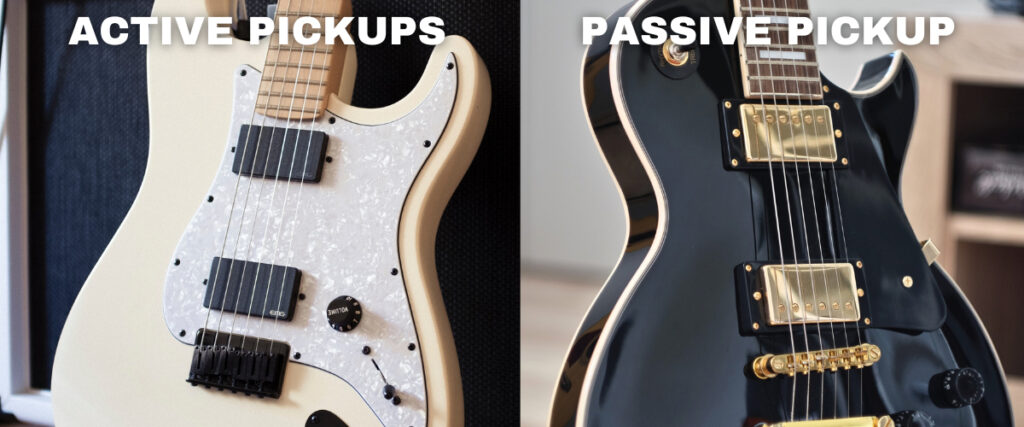
Passive Pickups
Most electric and bass guitars have passive pickups. This means that they do not require any power (i.e. a battery) to function.
Passive pickups consist basically of a bobbin (usually made from metal or plastic) with a magnets inserted which are then wrapped in coils of wire. Here is a side-view to demonstrate.
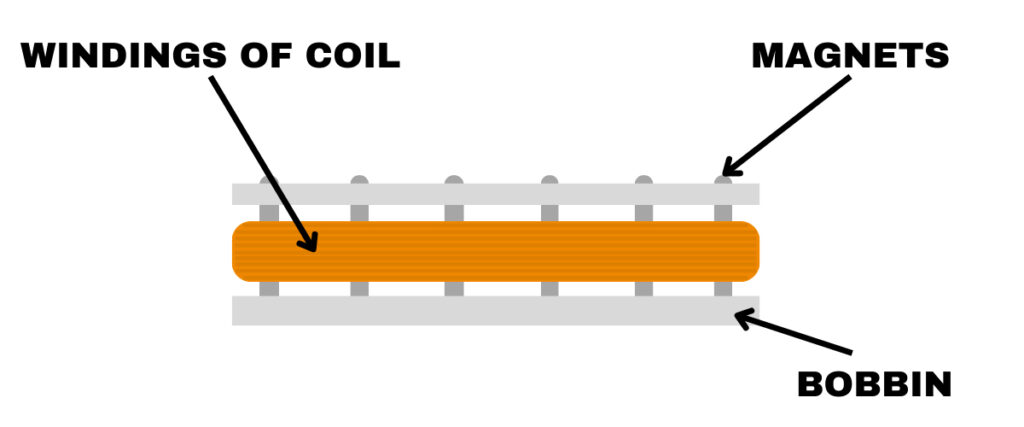
When the strings on the guitar vibrate, this interacts with the magnetic field of the pickup creating a signal which can be sent to the amplifier.
The tone of a passive pickup can be affected by several structural factors including:
- The type of magnet used e.g. alnico or ceramic
- How many coils there are e.g. single coil or humbucker which has two coils
- How many times the wire is wound around the magnet (coil windings)
- The size of the bobbin
One of the most important features to point out from the list above is how many times the wire is wrapped around the magnet, also known as the number of coil windings. The more coil windings there are, the higher the output of the pickup will be meaning they will sound distorted more easily. However, increasing the number of coil winds also changes the tone of the pickup.
More coil windings = less treble
This means that the pickup sounds less bright and loses clarity and definition. Hence, why you can’t just use a tonne of coil windings to get a high output pickup, as it will start to sound very muddy.
Check out my comparison between high and low output pickups to learn more.
| Pros | Cons |
| No battery required | Less high-end frequencies |
| More sensitive to dynamics of playing | More background hum and hiss |
| Very versatile (used in every music style) | Less sustain |
| Less expensive | Lower output (less suitable for high gain) |
Which Guitarists Use Passive Pickups?
- Steve Vai
- Yngwie Malmsteen
- Joe Satriani
- Dave Mustaine
- John Petrucci
Examples of Passive Pickups:
- DiMarzio D Activator
- Seymour Duncan JB Model
- Bare Knuckle Ragnarok
Active Pickups
Active pickups are based on the same structure as passive pickups (a bobbin, magnet and coils of wire), but also have a powered circuit (pre-amp) which is used to boost the signal. This pre-amp requires power to function so active pickups also require a 9V battery in order to work.
Another important structural difference is that active pickups have far fewer coil windings compared to passive pickups.
- Passive pickups typically have around 8,000-10,000 coil windings
- Active pickups usually only have 5,000-6,000 coil windings
Since active pickups have fewer coil windings, they retain a lot more treble frequencies and as a result sound brighter, crisper and more defined. The pre-amp is then able to boost the signal to get more output, resulting in more volume and distortion but without causing the pickup to sound muddy.
Active pickups can be single coil or humbuckers, although humbuckers are far more common.
| Pros | Cons |
| Retains brightness and clarity with high output | Requires a battery |
| Great for metal | Less versatile (best for high gain) |
| Less background hum and hiss | Not very sensitive to dynamics of playing |
| More sustain | More expensive |
Which Guitarists Use Active Pickups?
- James Hetfield
- Kirk Hammet
- Jakk Wylde
- Tosin Abasi
- Jim Root
Examples of Active Pickups:
- EMG 81
- Fishman Fluence Modern
- Seymour Duncan Blackouts
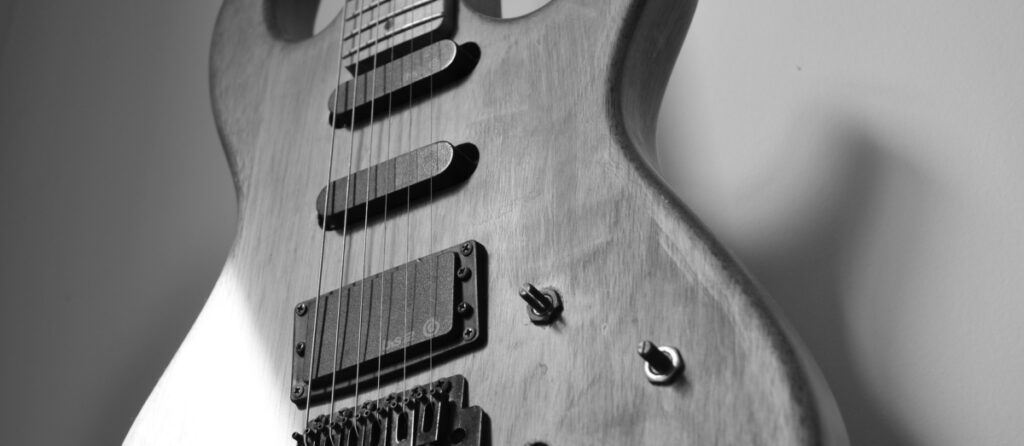
Active vs Passive (Direct Comparisons)
Now that we’ve been though the basics, let’s directly compare these two types of pickups. I’ll be addressing:
- Tone and output
- Background noise and interference
- Capacitance issues (loss of high-end frequencies)
- Effect on the guitar’s volume control
- Battery life
- Pickup cost
- Installation considerations
Tone and Output
There are several tonal differences between active and passive pickups:
- Active pickups have a higher output (due to the pre-amp) than passive pickups in most cases which means they sound louder and distort more easily.
- Active pickups usually sound a bit more crisp and clear with more treble emphasis compared to passive pickups. This is because active pickups use fewer coil windings.
- A guitar with active pickups typically has more sustain the magnetic pull on the strings is weaker due to the fewer coil windings.
- Passive pickups are more sensitive and respond to the dynamics of your playing more than active pickups which sound more compressed and consistent because they are less sensitive.
Active pickups are very popular for metal because you can get the high output but without sacrificing clarity as is often the case with a passive pickup that requires more coil windings to get the high output. That doesn’t mean that you absolutely need to get active pickups for metal, as there are many metal players out there who prefer passive pickups instead.
For low-gain and cleaner tones, passive pickups are typically more popular as they sound less aggressive. This is why passive pickups are generally considered more versatile than active pickups, so if you play a range of music styles then you may want to opt for passive pickups.
Check out this video to hear the difference between these active EMG 81 and passive Seymour Duncan Nazgul pickups.
Background Noise and Interference
We’re all familiar with the buzz and hum associated with using high gain or lots of guitar pedals. This is made worse if have a lot of mains powered devices in the vicinity.
Although humbucker pickups suffer significantly less from this issue than single coil pickups, if they are passive it is still often quite noticeable when using a lot of gain or volume.
Active pickups produce less background noise, hissing and humming compared to passive pickups as they have a lower noise-floor. This means that when using active pickups you can often get away with using high gain/ volume without a tonne of background noise.
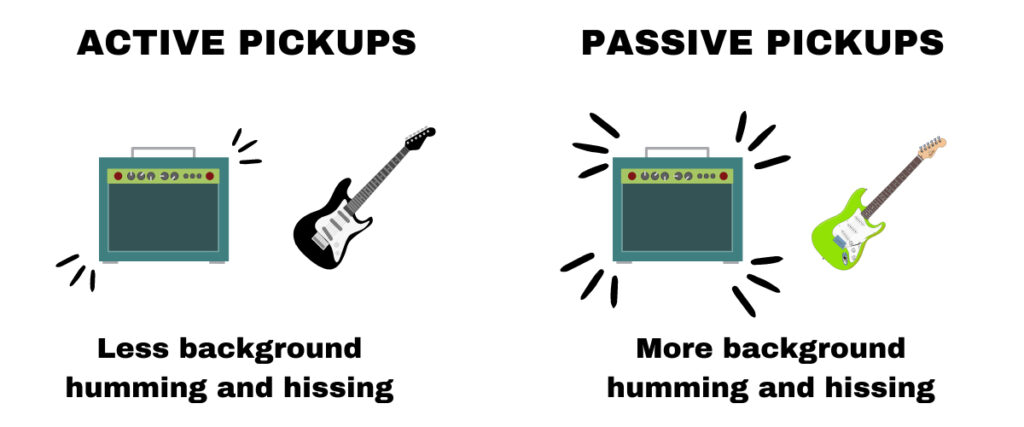
Capacitance Issues with Passive Pickups
If you are running a long guitar cable, or using a lot of pedals then you may notice that you are losing a lot of the high-end frequencies if you are using passive pickups. This is because excessive capacitance builds up.
Active pickups suffer a lot less from this excessive capacitance because they have low-impedance. This means that they retain a lot more of the high-end frequencies when using long cables or multiple pedals.
Otherwise, if you use passive pickups then you could need a buffer pedal near the start of your signal chain to counteract this problem. With active pickups, this need for a buffer pedal is reduced.
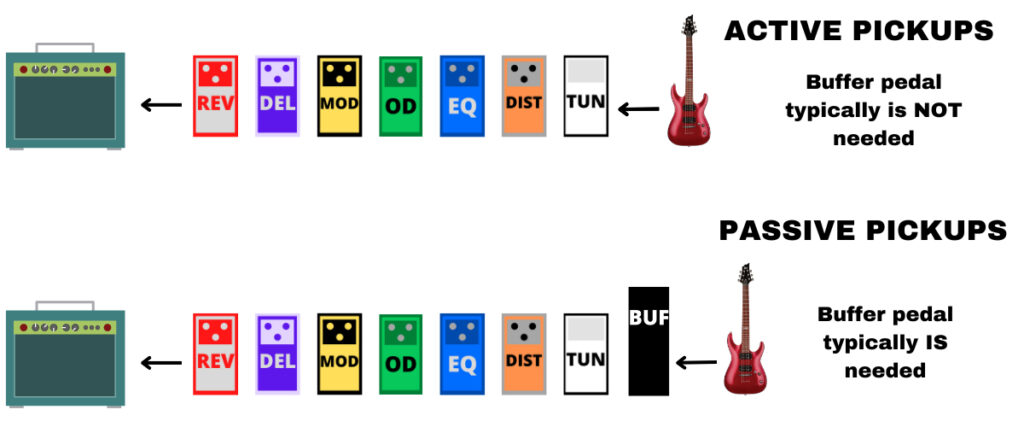
Effect on the Volume Control
On electric guitars and bass guitars with passive pickups, the volume control doesn’t just affect the volume. Lowering the volume control on the guitar will also cut some of the treble frequencies making the tone sound less bright and defined, and more warm and mellow.
On guitars with active pickups, the volume control will just adjust the volume and the tone will not be affected as well. This means, if you turn your volume from 10 to 2, the tone will still sound the same.
Some players prefer the way a passive pickups interact with the volume control, but others like to retain the same tone when adjusting the volume control so will prefer active pickups.
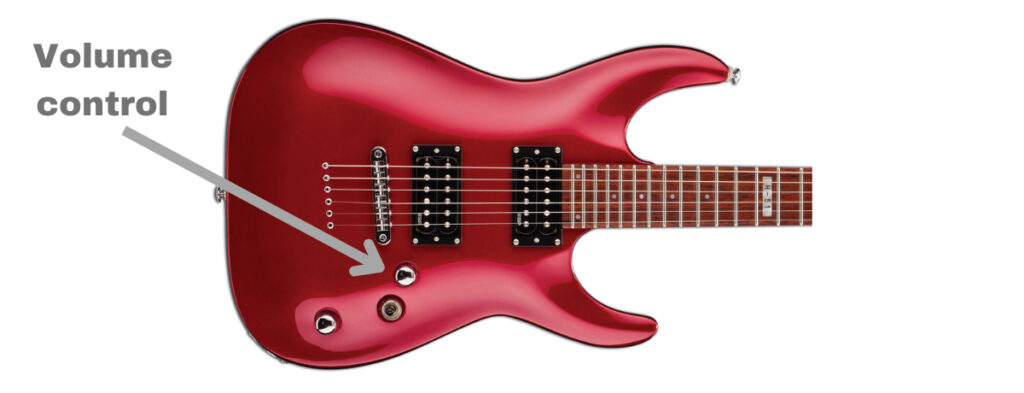
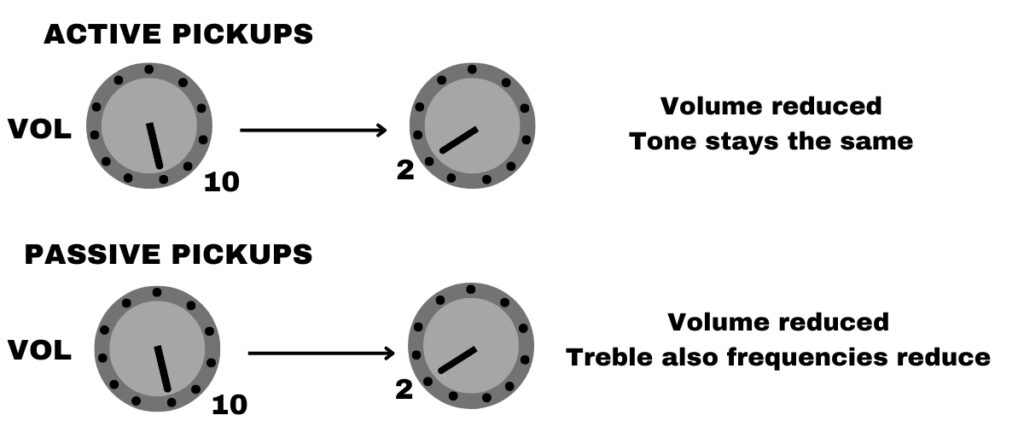
Battery Life
Passive pickups are very straightforward since they do not need a battery.
However, with active pickups, you’ll need to stay conscious of the battery life. When the battery dies in an active pickup, no signal will be sent to the amplifier and as a result, no sound will be produced from the amp.
The battery life is usually very good on most active pickups fortunately. Most EMG pickups last around 3000 hours with a 9V battery. However, if you are using two pickups (which most guitars have), then the battery life will be half that so the 9V battery will last 1500 hours.
There’s no way of knowing exactly how much battery life is left though, which can be a concern if you think you’ll run out mid-gig and haven’t changed the battery in a while. You’ll also need to make sure that you always disconnect your guitar from the cable whenever it is not in-use as this will still drain the battery.
Instead of a 9V non-rechargeable battery which is used in most active pickups (such as EMG), Fishman Fluence active pickups instead feature a 9V rechargeable lithium-ion battery which lasts 150-200 hours. These batteries can be recharged with a micro-USB connector.
Check out my comparison between EMG and Fishman Fluence active pickups.
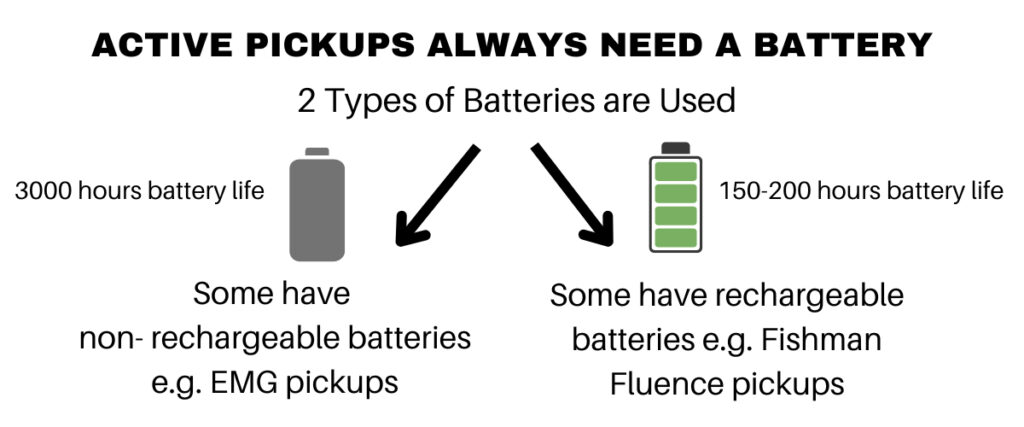
Cost of the Pickups
In general, passive pickups are slightly cheaper compared to active pickups. Here is a table comparing the prices of popular high-output passive and active pickups.
| Humbucker Pickup Set | Average Price |
| DiMarzio D Activator (passive) | $200 |
| Seymour Duncan JB (Passive) | $200 |
| EMG 81 (active) | $200 |
| Seymour Duncan Blackouts (active) | $218 |
| Fishman Fluence Modern (active) | $260 |

Switching from Passive to Active Pickups (or vice-versa)
If you switch from passive to active pickups (or vice-versa) there are two things you’ll need to address:
- The rest of the circuitry in the guitar e.g. tone and volume controls
- The space inside the guitar’s electronic cavity
Since active and passive pickups have difference impedances, and only active pickups have a pre-amp, the entire circuitry for the guitar will also need to be changed if you switch from passive to active, or active to passive pickups. This can add a significant cost and time expensive to the process.
Space must also be made in the guitar’s cavity for the 9V battery, which is another modification you will need to address if switching from passive to active pickups.
Which Should You Choose?
If you are playing any genre apart from metal then I personally think passive pickups are the way to go. They sound more natural and respond well to the dynamics of your playing, and they don’t need a battery which is a big plus.
If you like high-gain styles of music, then it really comes down to personal preference.
A lot of metal players like the compressed, crisp sound of an active pickup. However, there are also loads of heavy metal players who use passive pickups and prefer the more natural and open sound. There are plenty of great pickup manufacturers such as Seymour Duncan, DiMarzio and Bare Knuckle, who make very high output passive pickups which are perfect for metal.
Here are some more articles you might find useful:
